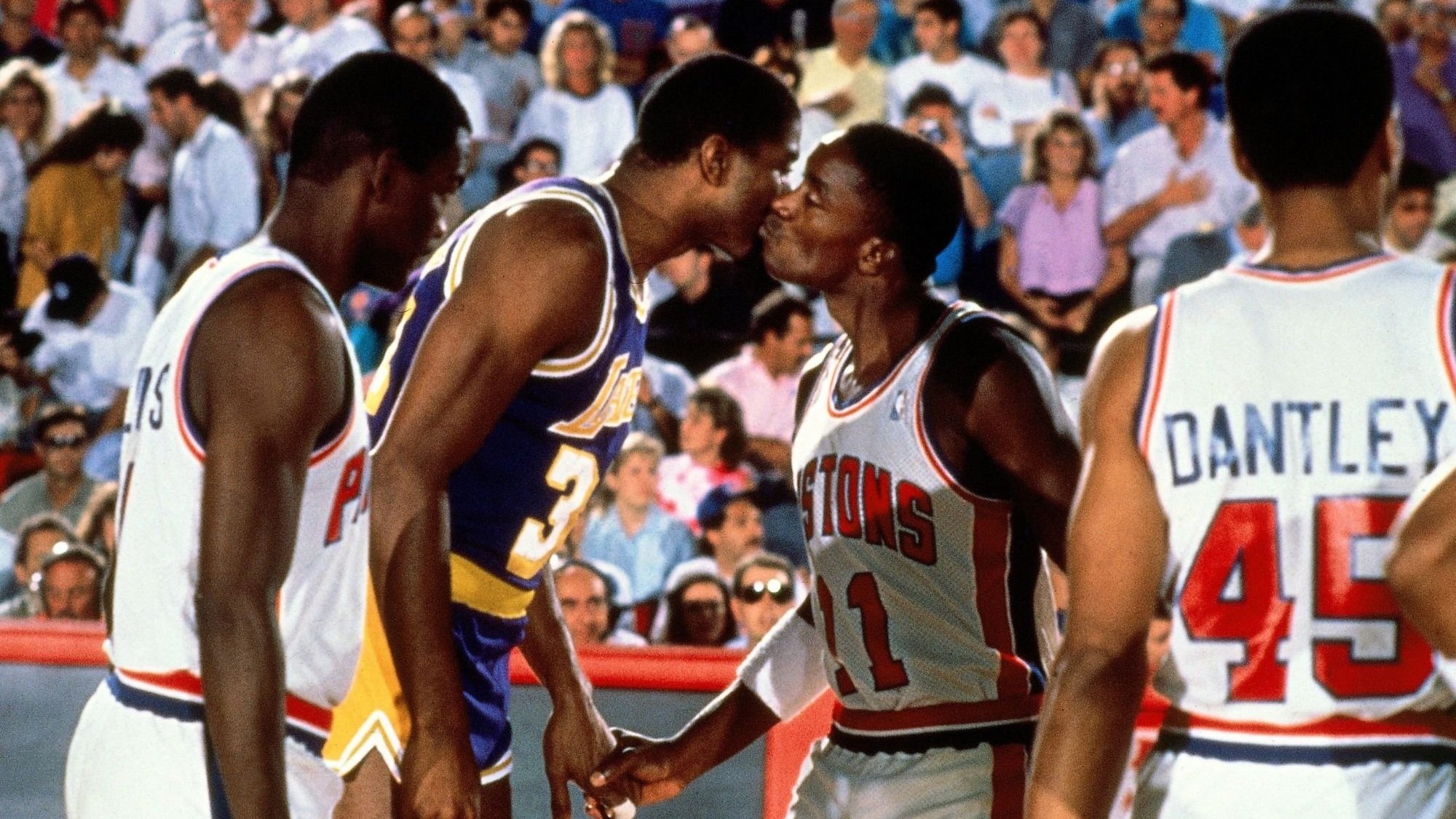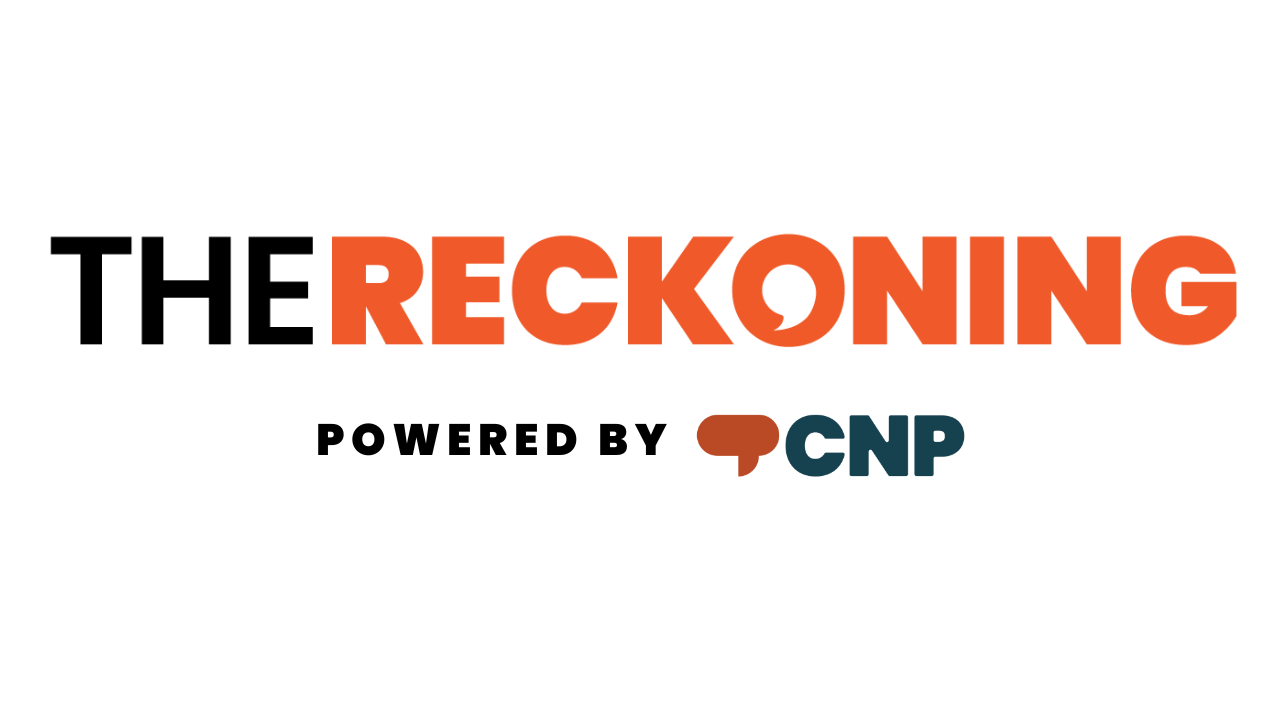An On-Court Kiss: Magic, Isiah and the Politics of Black Masculinity in the NBA

It’s unclear when and where the video was taken; probably during the early ‘80s in what looks like a kitchen or rec room. The unabashed love between the two young Black men — elite, twenty-something basketball players, together on a path to sports immortality — practically radiates through the screen.
The taller one, goateed and lanky in a striped polo shirt, looks into the camera, then drapes an arm around his “best friend,” boyish and clean-shaven, wearing a pastel suit and tie.
“Isiah Thomas is one of the best point guards to ever play the game,” says Earvin “Magic” Johnson, touching his head to Thomas’s as Thomas beams. “He shakes, bakes, dipsy-do, puts it in the hoop, super jumper, plays defense. And he’s my baby.”
He leans over and kisses Thomas on the head. “Your turn.”
Thomas erupts in laughter. “I learned it all from him”
On June 9, 1988, under the dazzling lights of the Great Western Forum in Los Angeles, the Los Angeles Lakers and their archrivals, the Detroit Pistons stepped to the hardwood floor for the first game of an eagerly anticipated, 7-game series that would decide the National Basketball Association championship.
Packed with cheering fans, the atmosphere crackled with energy, due in part to a clash of the cultures each team represented. The charismatic Earvin “Magic” Johnson led the Lakers’ star-powered “Showtime” lineup, a glamorous team tailor-made for glamorous Los Angeles. The Pistons, Isiah Thomas’s blue-collar squad, embraced their thuggish “Bad Boys” reputation, which fit the gritty Motor City like a mechanic’s worn leather glove.
As their teammates traded pre-game handshakes at center court, Johnson, an auto plant worker’s son from Lansing, Michigan, and Thomas, a native of Chicago’s hardscrabble West Side, stepped toward one another.
The best friends shook hands. Then they kissed one another on the cheek.
The duo had developed the ritual during their early days in the NBA, as their off-court friendship and on-court rivalry blossomed. Modeled after greetings of Italian men, both Thomas and Johnson saw it as a sophisticated gesture of respect as well as affection. They kissed whenever their teams met, win or lose, despite their reputations as fierce, take-no-prisoners competitors. Decades before social media, if the sports world noticed it didn’t seem to mind.
Yet on that day in June, in that instant, with so much at stake and millions of sports fans watching live, the intimate gesture between Thomas and Johnson became a historic moment that transcended the intensity of a professional sports championship. In several ways, it took on a life of its own.
DETROIT - 1987: Isiah Thomas #11 of the Detroit Pistons exchanges a kiss with Magic Johnson #32 of the Los Angeles Lakers during a 1987 NBA game at the Palace of Auburn Hills in Detroit, Michigan. (Photo by Andrew D. Bernstein/NBAE via Getty Images)
A Gesture of Friendship Became A Spark of Controversy
It changed the trajectory of the Detroit-Los Angeles series after Johnson’s coach, angry at the gesture, challenged his star player’s masculinity. It fueled rumors about Johnson’s sexuality, cracking open his once-unbreakable bond with Thomas. But to sports sociologists, The Kiss helps explain why a majority-Black pro sports league — one that sees itself as politically progressive and an all-in defender of LBGTQ rights — has had just one out gay player in its seven-decade history.
"Irrespective of class, status, income, or level of education, for many black men sexuality remains the place where dysfunctional behavior first rears its ugly head."
- bell hooks, Writer, Academic and Social Critic
After they lost an NBA finals game to the Pistons at the Forum, Pat Reilly, the Lakers’ legendary head coach, had more than a few choice words for Johnson in the locker room. The “Showtime” squad losing to the hated Bad Boys at home was bad enough; seeing Johnson exchange intimate pleasantries with Thomas — the enemy team’s leader — was infuriating. Behind closed doors, the future Hall of Fame coach called Johnson out, questioning both his loyalty and his manhood, in front of the team.
“Coach Reilly did not like that — that we hugged and kissed each other,” Johnson recalled during an NBA broadcast in 2017. “Then he said, ‘So what are you gonna do? Because your team thinks you’re gonna be soft.’”
Reilly wasn’t alone. Some saw it as a refreshing example of brotherly love transcending professional sports’ dog-eat-dog culture; Reilly and others, including sportswriters and some hardcore fans, saw a gesture that belonged in a gay nightclub, not on the NBA hardwood. Larry Bird, a contemporary NBA superstar and another future Hall of Famer, famously wasn’t thrilled: "I wanted to throw up.”
Masculinity, Homophobia, and the NBA
Dr. Douglas Hartmann, Professor of Sociology at the University of Minnesota, said he wasn’t surprised that the public display of affection between Johnson and Thomas was polarizing back in the day.
“Sport is an arena dominated by men and genuinely generally characterized by fairly extreme forms of masculinity and masculine behavior,” says Hartmann, author of Midnight Basketball: Race, Sports and Neoliberal Social Policy.
Hartmann says the sight of two professional athletes sharing a public display of affection more commonly seen between sorority sisters meeting for brunch didn’t cause a firestorm in the era before social media. Still, the gesture turned a few heads and flipped American social and cultural norms upside down. The fact that both men were Black, he says, added an extra dimension to the issue.
“The NBA, in particular, is really seen as a site of Black culture,” Hartmann says. “I think that in the culture, [Black] people who are associated with sports are somewhat more [socially] cautious and conservative than we often realize or are aware of — especially along lines of religion and gender and sexuality.”
In 2023, the percentage of Black players in the NBA was just over 70%, around 8 points higher than the percentage of Black players in both the NFL and Major League Baseball combined. Given its close association with hip-hop music, fashion, and aesthetic — in the league’s official marketing as well as among the players, on and off the court — there’s little question that Black culture dominates a league that raked in $11.3 billion in revenue last year.
But Hartmann and others say that affiliation includes some heavy cultural baggage; including societal expectations of Black masculinity and sexuality, particularly among athletes. Male team sports culture tends to feature a strong homophobic streak; therefore, showing genuine affection, vulnerability or attraction towards another man usually leads to group scorn and ostracization. That dynamic, Hartmann says, effectively marginalizes any player who isn’t straight or macho, keeping him from presenting as his authentic self.
A 2020 study puts a finer point on it, finding that "most gay and bisexual males (71%) and half (50%) of gay and bisexual females … believed homophobia to be more common in team sporting environments than in general society."
Johnson, the Lakers’ superstar, seemed to prove that data point in the game after Reilly’s locker-room tirade. As Thomas drove towards the basket, Johnson clobbered him with an elbow: “I slammed him. And we started fighting.”
The aggression apparently was Johnson’s attempt “to react against and assert” his masculinity, Hartmann says. “‘You know, ‘This is guy friendship — not anything else other than that. And let me show you.’ And then go out and over-exaggerate, be physically assertive and try to dominate.”
It worked, in a sense: the Lakers defeated the Pistons. Los Angeles would go on to take the series, winning 4 games to Detroit’s 3.
“If I had my way, someone else would have already done this. Nobody has, which is why I'm raising my hand.”
- Jason Collins, the NBA’s first and only openly gay player, in a 2013 essay
Hartmann says that while many NBA players may be culturally conservative, the league as a whole isn’t. It openly supports progressive causes, ranging from the Black Lives Matter movement to justice for the LGBTQIA+ community. But The Kiss has been shoved down the league’s memory hole.
In 2017, for example, the league moved its lucrative All Star Weekend from Charlotte, North Carolina to New Orleans after the North Carolina state legislature passed a bill requiring trans children in public schools to use the bathroom for the gender assigned to them at birth.
“That was a pretty significant stand,” Hartmann says. Yet The Kiss between Thomas and Johnson, he says, “has kind of been intentionally ignored, minimized, or even kind of suppressed” for reasons no one can fully explain.
The Legacy of The Kiss
In the ensuing years after The Kiss, petty beefs and drama — including Johnson’s suspicion that Thomas spread rumors that the womanizing Johnson also slept with men after the Lakers star contracted HIV in 1991, and Thomas’s resentment that Johnson was instrumental in excluding him from the storied “Dream Team” that won gold in the 1992 Olympics — drove the former best friends apart; for nearly 30 years, they barely spoke to one another. They squashed their beef for good, though, in a tearful, on-camera reconciliation in 2017.
Still, the shadow of The Kiss lingers. Hartmann says the homophobia in NBA locker rooms helps explain why Jason Collins — a little-known reserve player with the Boston Celtics who retired in 2016 — made history as the NBA’s only out, gay player.
After playing professionally for more than a decade, Collins came out publicly in May 2013 in a cover-story essay for Sports illustrated. In it, he wrote about the psychological weight of wearing the straight mask: presenting as a manly, dependable, workaday teammate inside the locker room; a very tall, handsome gay man, his authentic self, outside of it.
Yet, in his essay, Collins also seems to embrace the macho extreme of professional athletics, explicitly defending himself against the “soft” gay stereotype. He insisted he’s been an “aggressive” player since high school, and once hit a college opponent so hard the player left the court on a stretcher.
“Am I so physical to prove that being gay doesn't make you soft? Who knows?” he wrote, blithely waving away the irony. “That's something for a psychologist to unravel…Winning is what counts.”
Collins’ attitude is an example of what Hartmann says is the “institutional and public pressure” Black athletes face to be macho, defining the “mask” Black gay athletes must wear.
“The realities are that men dominate the most popular and profitable sports, and that most of the cultural characteristics associated with it are the extremes of masculinity,” Hartmann says. “And in that context, when masculinity is kind of dominant, any threats to it are particularly a problem,” particularly if that threat is inside the locker room.
Still, it’s likely that Collins wasn’t the only gay player in the NBA. But until attitudes make it safer for a player to come out — attitudes that led to criticism of Johnson and Thomas — the closet is likely to remain locked.
Joseph Williams is The Reckoning’s Race & Health Editor. A seasoned journalist, political analyst and essayist, Williams has been published in a wide range of publications, including The New York Times, The Washington Post, Politico, The Boston Globe, The Atlantic, and US News & World Report.
A California native, Williams is a graduate of the University Of Richmond and a former Nieman Fellow at Harvard University. He lives and works in metro Washington, D.C.

